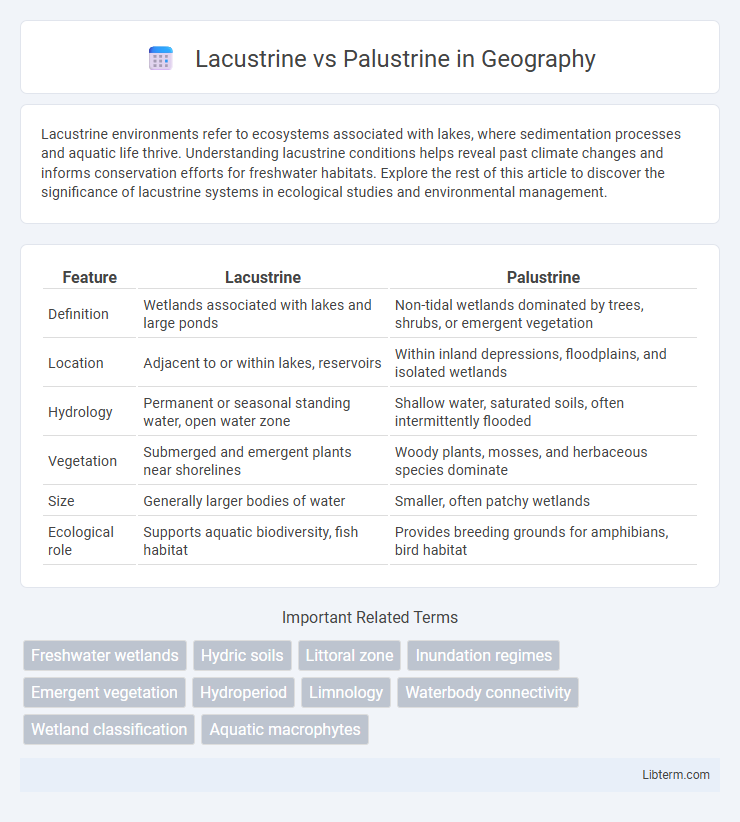Lacustrine environments refer to ecosystems associated with lakes, where sedimentation processes and aquatic life thrive. Understanding lacustrine conditions helps reveal past climate changes and informs conservation efforts for freshwater habitats. Explore the rest of this article to discover the significance of lacustrine systems in ecological studies and environmental management.
Table of Comparison
| Feature | Lacustrine | Palustrine |
|---|---|---|
| Definition | Wetlands associated with lakes and large ponds | Non-tidal wetlands dominated by trees, shrubs, or emergent vegetation |
| Location | Adjacent to or within lakes, reservoirs | Within inland depressions, floodplains, and isolated wetlands |
| Hydrology | Permanent or seasonal standing water, open water zone | Shallow water, saturated soils, often intermittently flooded |
| Vegetation | Submerged and emergent plants near shorelines | Woody plants, mosses, and herbaceous species dominate |
| Size | Generally larger bodies of water | Smaller, often patchy wetlands |
| Ecological role | Supports aquatic biodiversity, fish habitat | Provides breeding grounds for amphibians, bird habitat |
Introduction to Lacustrine and Palustrine Systems
Lacustrine systems encompass freshwater lakes and reservoirs characterized by open water with depths sufficient to prevent rooted vegetation, supporting diverse aquatic life and sediment deposition. Palustrine systems consist of non-tidal wetlands, such as marshes, swamps, and bogs, dominated by emergent vegetation and saturated soils, serving crucial roles in water filtration and habitat provision. Understanding the hydrology, vegetation types, and sedimentation patterns in these contrasting ecosystems is essential for wetland delineation and conservation efforts.
Defining Lacustrine Wetlands
Lacustrine wetlands are defined by their location within or adjacent to permanent bodies of standing water such as lakes and reservoirs, featuring water depths exceeding 2 meters and often exhibiting open water zones with sparse emergent vegetation. These wetlands support diverse aquatic ecosystems due to stable hydrological conditions and water chemistry influenced by large water volumes. In contrast, palustrine wetlands are characterized by smaller, shallow water bodies with extensive emergent vegetation, typically occurring in isolated depressions, swamps, or marshes without continuous surface water connections to lakes or rivers.
Understanding Palustrine Wetlands
Palustrine wetlands are inland, non-tidal wetlands dominated by trees, shrubs, and emergent vegetation, often found in marshes, swamps, and bogs, distinguished from lacustrine wetlands which are associated with large open water bodies like lakes and reservoirs. Palustrine wetlands play a critical role in biodiversity support, water filtration, and flood control due to their saturated soils and diverse plant communities. Understanding palustrine systems involves recognizing their hydrology, soil types, and vegetation characteristics essential for wetland conservation and management policies.
Key Differences Between Lacustrine and Palustrine Ecosystems
Lacustrine ecosystems are characterized by large, deep bodies of freshwater such as lakes, often supporting diverse aquatic life and stable water levels. Palustrine ecosystems encompass marshes, swamps, and bogs with shallow, often fluctuating water levels and abundant emergent vegetation adapted to saturated soils. Key differences include lacustrine systems' reliance on open water habitats versus palustrine systems' dominance by wetlands with hydric soils and dense plant communities.
Hydrology and Water Sources Comparison
Lacustrine systems are characterized by large, deep, and perennial water bodies primarily fed by precipitation, groundwater inflow, and surface runoff, sustaining stable hydrological regimes. Palustrine systems consist of smaller, often shallow wetlands receiving water mainly from surface runoff, precipitation, and groundwater seepage, resulting in more variable and intermittent hydrology. The hydrological distinction lies in lacustrine systems' predominantly lacustrine basin water storage versus palustrine wetlands' saturated soils and vegetation-driven water retention.
Biodiversity in Lacustrine vs Palustrine Habitats
Lacustrine habitats, characterized by large, stable water bodies such as lakes, support high biodiversity including diverse fish, amphibians, and aquatic plants adapted to deep and open water conditions. Palustrine habitats, encompassing marshes, swamps, and bogs, harbor a rich array of specialized species like amphibians, waterfowl, and emergent vegetation thriving in shallow, nutrient-rich, and frequently fluctuating water levels. The structural complexity and nutrient availability in palustrine environments often drive greater species diversity compared to the more stable, open-water lacustrine systems.
Human Impacts on Lacustrine and Palustrine Wetlands
Human impacts on lacustrine and palustrine wetlands often result in habitat loss, altered hydrology, and reduced water quality. Urbanization, agriculture, and industrial activities contribute to nutrient loading, sedimentation, and pollution that degrade these wetland ecosystems. Restoration efforts focus on mitigating these impacts by improving water management and reducing contaminant inputs to preserve biodiversity and ecosystem services.
Ecological Functions and Services
Lacustrine ecosystems, characterized by deep, open-water habitats such as lakes, provide critical ecological functions including nutrient cycling, habitat for aquatic species, and carbon sequestration. Palustrine wetlands, often dominated by emergent vegetation, deliver essential services like water filtration, flood control, and breeding grounds for amphibians and waterfowl. Both systems support biodiversity, but palustrine wetlands excel in hydrological regulation while lacustrine environments are key for sustaining fish populations and aquatic food webs.
Wetland Classification and Mapping
Lacustrine wetlands are freshwater systems characterized by deep, standing water such as lakes and reservoirs, typically larger than 8 hectares with less than 30% emergent vegetation cover, making them significant in wetland classification for mapping large open water bodies. Palustrine wetlands encompass smaller, non-tidal freshwater wetlands dominated by trees, shrubs, and emergent vegetation, including marshes, swamps, and bogs, often identified by their saturated soils and persistent hydrology in wetland mapping protocols. Accurate classification and mapping of lacustrine and palustrine systems are essential for ecological assessment, resource management, and regulatory frameworks as defined by the U.S. Fish and Wildlife Service's National Wetlands Inventory.
Conservation Strategies for Lacustrine and Palustrine Wetlands
Conservation strategies for lacustrine wetlands focus on maintaining water quality, managing shoreline development, and protecting native aquatic species through designated buffer zones and pollution controls. Palustrine wetland conservation emphasizes preserving hydrological regimes, restoring native vegetation, and preventing encroachment from agriculture or urbanization. Both wetland types benefit from monitoring programs, invasive species management, and community engagement to sustain ecological functions and biodiversity.
Lacustrine Infographic

 libterm.com
libterm.com